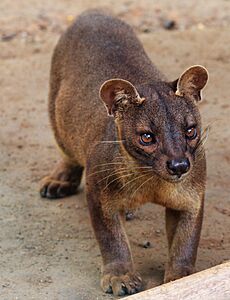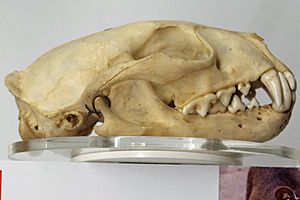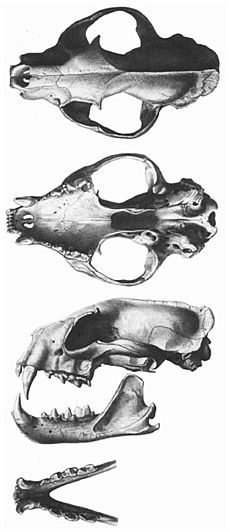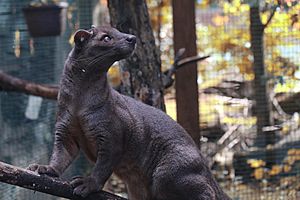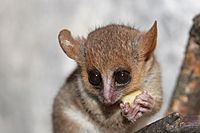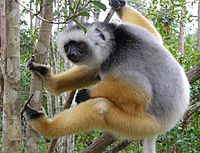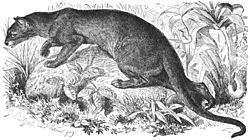Fossa (animal) facts for kids
Quick facts for kids Fossa |
|
|---|---|
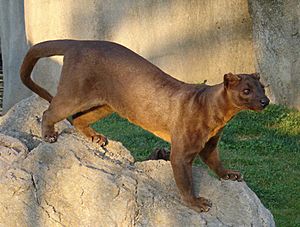 |
|
| At the Valencia Bioparc | |
| Conservation status | |
| Scientific classification | |
| Genus: |
Cryptoprocta
|
| Species: |
ferox
|
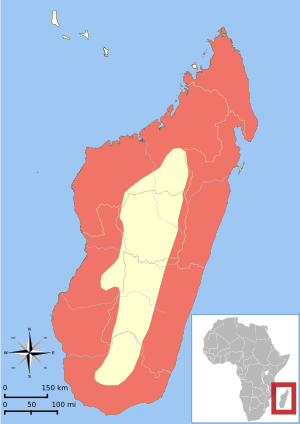 |
|
| Distribution of Cryptoprocta ferox (red-shaded area) | |
| Synonyms | |
|
|
The fossa (Cryptoprocta ferox; FOSS-ə or FOO-sə;) is a unique and fascinating animal found only on the island of Madagascar. It looks a bit like a cat, with a long, slender body and a tail that's almost as long as its body. The fossa is the biggest carnivore (meat-eater) on Madagascar.
Fossas are amazing climbers! They have special claws that can extend (but not fully retract like a house cat's) and very flexible ankles. These features help them climb up and down trees head-first and even jump between branches. They are active both day and night, hunting for food. More than half of their diet is made up of lemurs, which are also unique to Madagascar. Fossas also eat other small animals like tenrecs, rodents, lizards, and birds.
Sadly, the fossa is considered a vulnerable species because its forest home is shrinking. People in Madagascar sometimes fear the fossa, but many also protect it through traditional beliefs called fady.
Contents
What is a Fossa?
A Unique Malagasy Carnivore
The fossa is a mammal that belongs to a special family called Eupleridae. All members of this family live only on Madagascar. For a long time, scientists weren't sure if the fossa was more like a cat or a civet (another type of mammal). But genetic studies have shown that all of Madagascar's carnivores, including the fossa, are related to each other and to mongooses found in Asia and Africa. This means they all came from a single ancestor that arrived on the island millions of years ago.
There was once an even bigger relative of the fossa, called Cryptoprocta spelea or the giant fossa. It was about twice the size of today's fossa but likely died out before the year 1400.
Fossa Features
Body and Appearance
An adult fossa can be about 70 to 80 centimeters (28 to 31 inches) long, not including its tail. Its tail adds another 65 to 70 centimeters (26 to 28 inches) to its length! Males are usually a bit larger than females, weighing between 6.2 and 8.6 kilograms (13.7 to 19 pounds), while females weigh 5.5 to 6.8 kilograms (12 to 15 pounds).
Fossas have short, reddish-brown fur that is smooth and doesn't have any spots or patterns. Their undersides are a lighter, creamy color. Young fossas are often gray or almost white. They have excellent senses of smell, hearing, and sight, which are very important for hunting. Their eyes reflect light, glowing orange in the dark, much like many animals that are active at night.
Amazing Adaptations for Climbing
The fossa's body is perfectly designed for life in the trees. Its long tail acts like a balancing pole, helping it move through branches. Its claws are strong and can extend to grip tree bark, making it an expert climber. The soles of its paws are tough and padded.
What's really special are its flexible ankles. These allow the fossa to turn its hind feet almost completely backward. This means it can easily grip tree trunks and climb down head-first, or even leap from one tree to another with great agility.
Where Fossas Live
Forest Homes in Madagascar
The fossa lives all over Madagascar, but only in areas with forests. They prefer healthy, undisturbed forests, but you can sometimes find them in forests that have been changed a bit by humans, though in smaller numbers. They live in all kinds of Malagasy forests, from the dry forests in the west to the humid rainforests in the east and the spiny forests in the south.
Fossas can live at different heights, from lowlands to high mountains. They have been found at elevations from 440 meters (1,440 feet) up to 2,000 meters (6,560 feet) in protected areas. This shows how adaptable they are to different environments within Madagascar's forests.
Fossa Behavior and Hunting
Daily Life and Social Habits
Fossas are active throughout the day and night, meaning they don't stick to a strict daytime or nighttime schedule. They often have bursts of activity in the early morning, late afternoon, and late at night. They usually don't sleep in the same spot every night, unless a mother has young pups.
Most fossas live alone, except for mothers with their young, or sometimes a pair of males. However, scientists have seen groups of male fossas hunting together. In one amazing observation, three male fossas worked together to hunt a large lemur! This kind of teamwork might be a leftover behavior from a time when they hunted even bigger, now-extinct lemurs.
Fossas communicate in several ways. They make different sounds, like purring, threatening calls, and yelps. They also use special scent glands to leave messages on rocks and trees. They can also use their faces and body movements to communicate, though we don't fully understand all these signals yet.
What Fossas Eat
The fossa is Madagascar's top predator. It hunts small to medium-sized animals. Its favorite food is lemurs, and it's the only animal on the island that can hunt and eat adult lemurs of all sizes.
Scientists study what fossas eat by looking at their droppings, called scats. These scats are gray, cylinder-shaped, and about 10 to 14 centimeters (4 to 5.5 inches) long. Studies show that lemurs make up over 50% of a fossa's diet. They also eat tenrecs, lizards, birds, and other small mammals. Sometimes, they even eat insects and crabs.
Fossas hunt both on the ground and in the trees. When hunting in groups, one fossa might chase lemurs through the trees, forcing them down to the ground where another fossa can catch them. Fossas are known to eat the insides of their larger lemur prey, which helps scientists identify their kills. Sometimes, fossas will hunt farm animals like chickens, which can cause problems with people.
The Fossa Life Cycle
Reproduction and Young
Fossas usually mate in September and October, often high up in trees on strong, horizontal branches. These special mating trees are sometimes used year after year. Several males might gather around a female, and she seems to choose which males she mates with. The mating process can be quite long, lasting for several hours. A female might stay in the mating tree for up to a week, mating with different males. This unique strategy helps fossas find mates even when their population is spread out.
After about 90 days, the female gives birth to a litter of one to six pups, though two to four is most common. She finds a hidden spot for her den, like an underground burrow, a termite mound, a rock crevice, or a hollow tree. The newborn pups are tiny, weighing less than 100 grams (3.5 ounces), and are born blind and without teeth. Their fur is thin and light-colored.
After about two weeks, the pups' eyes open, and they start to become more active. Their fur also gets darker. They don't start eating solid food until they are about three months old and don't leave the den until they are around 4.5 months old. They are weaned (stop drinking milk) shortly after that. By the time they are one year old, young fossas are independent from their mother. They reach their full adult size around two years old, but they aren't ready to have their own babies until they are three or four years old. In zoos, fossas can live for more than 20 years!
Young fossas can sometimes be hunted by large snakes or birds of prey.
Fossas and People
Conservation Status and Threats
The fossa has been listed as "Vulnerable" by the IUCN Red List since 2008. This means its population has likely decreased by at least 30% between 1987 and 2008. The biggest threat to fossas is the destruction of Madagascar's forests, which is their home. As forests disappear, so do the lemurs they rely on for food.
Scientists estimate that there are fewer than 2,500 adult fossas living in protected areas. Because their population is so spread out and their numbers are low, fossas are very sensitive to changes in their environment. If fossas disappear, it could seriously affect the balance of Madagascar's ecosystems, as their prey species might become too numerous.
Cultural Beliefs and Conflicts
In Madagascar, traditional beliefs called fady sometimes help protect the fossa. However, in some areas, people fear the fossa, seeing it as a dangerous animal that preys on chickens, piglets, and even, in folklore, small children. Because of this, fossas are sometimes hunted for their meat or killed if they come into villages looking for food. Traps are sometimes set near chicken coops.
Fossas in Zoos
Fossas are sometimes kept in zoos, where they are part of breeding programs to help protect the species. The first fossas bred in captivity were in a French zoo in 1974. A German zoo later started a very successful breeding program, and many of the fossas in zoos today are descendants of that group. Studying fossas in zoos helps scientists learn more about their biology and how to protect them in the wild.
The fossa even appeared as a character in the 2005 animated movie Madagascar, where they were shown as the lemurs' main predators!



